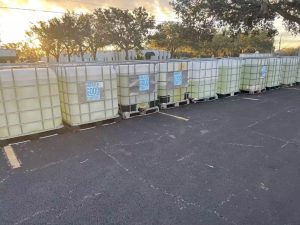Tankers of Sugar Syrup and Pollen Aided 1.7 Billion Bees Affected by Hurricane Ian
Among Hurricane Ian’s victims were tens of thousands of honeybee colonies.

Huge containers of bee syrup. Greater Good Charities
When Hurricane Ian tore through Florida earlier this fall, among its victims were tens of thousands of honeybee colonies. With vegetation uprooted and feeders wiped out, the bees were left with no food source.
“Early estimates are that tens of thousands of hives have been destroyed along with many of the feeders used by beekeepers,” Brooke Nowak, vice president for people and plant programs at Greater Good Charities, tells TreeHugger.
“The storm also wiped out much of the natural forage used to feed pollinators leaving the bee populations who did survive at risk of starving.”
In order to help the bees survive, Greater Good Charities hastily organized an emergency delivery of five tanker trucks of sugar syrup and thousands of pounds of pollen replacement to beekeepers in the state.
The organization worked with Cargill, a food corporation based in Minnesota, and beekeeping supplier Mann Lake. They held three events that donated more than 508,800 pounds of sugar and more than 96,900 pounds of bee pollen substitute to help nearly 1.7 billion bees affected by the hurricane.
The goal was to help feed the bees for 30 days to help beekeepers rebuild.
“But our partners tell us the destruction was so severe it will take much longer for them to rebuild,” Nowak says. “There was massive damage to the equipment and the bees.”
Most bees die during a hurricane, flood, or other disasters because of the way hives are built. Both natural and man-made hives have openings at the bottom. During a natural disaster, the bees’ instinct is to go up, so they are often trapped and can’t get out.
“According to our partner, Mann Lake, the most important thing right now is keeping the queens well fed so that they continue to lay eggs of both the worker bees and future queens,” Nowak says.
Hurricane Ian was a Category 4 Atlantic hurricane that caused significant damage in western Cuba and the southeastern United States, primarily in Florida and South Carolina. It made landfall in Florida on Sept. 28 and was soon downgraded to a tropical storm, with destructive rainfall. At least 119 people died due to the storm.
According to a report from Florida State Beekeepers Association, 1,500 beekeepers were affected by the storm with 100,000 hives destroyed. That doesn’t include other impacts, like bee colonies that were lost to issues such as disease, beetle predators, or lack of foraging.
“The damage to equipment and bees was equally devastating. Another factor is the loss of revenue for honey processing, as this is the late season harvest,” John Coldwell, president of the Florida Beekeepers Association, tells TreeHugger.
“Beekeepers not only need new equipment; the bees and queens are at inflated prices and limited availability. This is a demanding process as they are committing financial reserves to rebuild and access to stock, bees, and queen and food are limited.”
In order to rebuild colonies, they need good weather and to have the natural foliage recover. Coldwell says this has to happen before February or March or they may not recover.
There are nearly 5,000 registered beekeepers in Florida, managing approximately 630,000 colonies, according to the University of Florida. Honey bees contribute almost $20 billion to the crop industry by providing pollination services throughout the United States, and Florida’s honey industry is ranked among the top five states in the country.
We are here to share current happenings in the bee industry. Bee Culture gathers and shares articles published by outside sources. For more information about this specific article, please visit the original publish source: Tankers of Sugar Syrup Aided 1.7 Billion Bees Affected by Hurricane Ian (treehugger.com)






